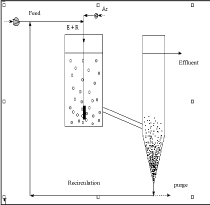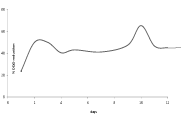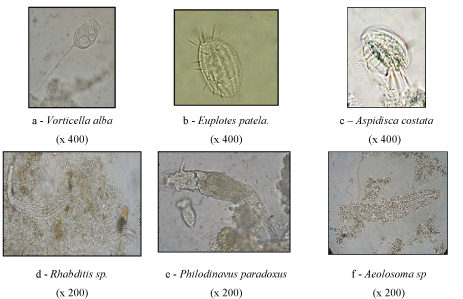Research Article Open Access
Identification of Microbiota for Activated Sludge Acclimated By Paper Mill Effluent Kraft E1 Bioremediation
| Lívia Cordi1, Márcia Regina Assalin2, Alexandre Nunes Ponezi3 and Nelson Durán1,4* | |
| 1Institute of Chemistry, Biological Chemistry Laboratory, Universidade Estadual de Campinas, P.O.Box 6154, 13083-970, Campinas-SP, SP, Brazil | |
| 2EMBRAPA (Environment), Rodovia SP 340 km 127.5, Tanquinho Velho, P.O.Box 69, 13820-000, Jaguariúna, SP, Brazil | |
| 3Division of Microbial Resources, Research Centre for Chemistry, Biology and Agriculture (CPQBA), Universidade Estadual de Campinas, P.O.Box 6171, Campinas, SP, 13081-970, Brazil | |
| 4Center of Natural and Human Sciences, Universidade Federal do ABC, Santo André, SP, Brazil | |
| Corresponding Author : | Nelson Duran Institute of Chemistry Biological Chemistry Laboratory Center of Natural and Human Sciences Universidade Federal do ABC Santo André, SP, Brazil Tel: 55 19 3521-3149 E-mail: duran@iqm.unicamp.br |
| Received: December 22, 2011; Accepted: October 12, 2012; Published: October 14, 2012 | |
| Citation: Cordi L, Assalin MR, Ponezi AN, Durán N (2012) Identification of Microbiota for Activated Sludge Acclimated By Paper Mill Effluent Kraft E1 Bioremediation. J Bioremed Biodeg 3:169. doi:10.4172/2155-6199.1000169 | |
| Copyright: © 2012 Cordi L, et al. This is an open-a ccess article distributed under the terms of the Creative Commons Attribution License, which permits unrestricted use, distribution, and reproduction in any medium, provided the original author and source are credited. | |
Related article at Pubmed Pubmed  Scholar Google Scholar Google |
|
Visit for more related articles at Journal of Bioremediation & Biodegradation
Abstract
Conventional systems treating paper effluents and cellulose are quite efficient in the reduction of Chemical Oxygen Demand (COD) and Biochemical Oxygen Demand (BOD). In general, there is primary stage clarification followed by secondary treatment, usually with a biological system (activated sludge). However, for the efficient degradation of some organic compounds in this effluent, adapted microorganism accomplish the treatment which are necessary resulting in effluents with low concentrations of recalcitrant compounds. There are two methods for microorganism acclimation: genes cloning or natural.
In this work, the original biomass collected from a domestic sewage treatment plant was adapted for application in the bioremediation of paper mill effluent, Kraft E1. So, the aim of this work was verifying the correlation of protozoa organisms and physical-chemical parameters during the acclimation period.
The acclimation of the biomass was verified mainly through the reduction of COD. The monitoring of biomass growth was followed by measurement of suspended solids and volatile suspended solids. Parameters such as pH, Dissolved Oxygen (DO) and temperature were also monitored daily. The biological study was accomplished microscopically through the identification of protozoa that are considered bioindicators of the activated sludge system. The biomass acclimation period was 39 days. The stabilization of the system was observed through constant rates of total COD (56%). The suspended solids at the beginning of the acclimation phase were from 1580 mg L-¹ to 3580 mg L-¹, indicating biomass growth. A small acclimation period was necessary to observe the diversity of protozoa, mainly free ciliates, but nematodes were also present, indicating poor sludge sediment. At the end of the acclimation phase predominantly rotifers, but some free ciliates, ciliated communities and fixed ciliated were observed, indicating a good purification capacity of the system. Within the organisms amoeba was observed and this indicates good quality to the final effluent. Then, it is possible to correlate the biota presence with the high capacity of COD removal from the activated sludge system.
| Keywords |
| Biomass; Wastewater treatment; Activated sludge; Microorganism; Protozoa; Biomarker |
| Introduction |
| The pulp and paper industry is considered to be a serious environmental hazard due to the multiplicity of impurities to the complexity of the chemical structures present and to the significant quantities of wastewater generated [1,2]. This industry sector discharges large volumes of brown colored effluents as a result of the different processes applied in wood and pulp bleaching, generating diverse pollutants [3,4]. The high chemical diversity of these pollutants causes a variety of clastogenic, carcinogenic and mutagenic effects on fish and other aquatic communities in recipient water bodies [5]. |
| The main treatment process used at pulp and paper mill plants involves primary clarification, succeeded by secondary treatment, generally of a biological nature. There are numerous biological treatment systems available, the most common being the activated sludge process [6,7]. |
| Activated sludge system technology consists basically in the agitation of the effluent in the presence of aerobic bacteria, protozoa, metazoa and atmospheric oxygen for a sufficient period to metabolize and to flocculate a large part of the organic material [8-10]. |
| The most common organisms that participate in the biodegradation of organic material in the biological system for effluent treatment are bacteria, protozoa and annelids [8,11,12]. The presence of particular types of protozoa is related to effluent quality and plant performance, so they can be used as bioindicators [13]. Protozoa play a secondary but important role in wastewater system purification [14-16]. |
| The protozoa in the activated sludge treatment process fall into four main classes: amoebae, flagellates and ciliates (free-swimming, crawling and stalked) and metazoa that are separated into rotifers, nematodes (sub-class) and Oligotrichia such as Aelosoma [14,17]. |
| To apply the activated sludge process to industrial effluents, which have specific compositions, effluent characterization is needed before treatment and the sludge needs to be acclimatized (microorganism acclimation to the effluent to be treated) [18,19]. The aim of this work was verifying the changes of the activated sludge microorganisms during acclimation period in the bioremediation of paper mill effluent from the Kraft E1 process. |
| Materials and Methods |
| Paper mill effluent |
| Wastewater was obtained from a bleach Kraft mill located in the Campinas city region (São Paulo State, Brazil). This mill process uses only Eucalyptus grandis wood. Sample effluent was obtained after the first alkaline extraction stage (E1). The aqueous samples were stored at 4°C in bottle flasks and used without prior filtration. |
| Acclimation of activated sludge to kraft E1 paper effluent |
| The acclimation of the activated sludge biomass from the Samambaia Sewage Treatment Plant, in a suburb of eastern region of Campinas, SP, Brazil, was studied for 39 days by the natural selection method. The biomass acclimation was followed by COD reduction from the effluent. The biomass growth was observed by Suspended Solids (SS) and Volatile Suspended Solids (VSS). The activated sludge was collected and acclimated in a reactor (Figure 1) by specific conditions using a Kraft E1 effluent as feed to microorganisms presents in the biological system. |
| Activated sludge system |
| An aerobic reactor (2.5 L) was operated as a continuous system and continuously fed with Kraft E1 effluent (at pH 7) by means of a peristaltic pump. The Hydraulic Retention Time (HRT) was maintained at 12 h. The sludge was periodically recycled, and excess sludge which grew during the aeration stage was withdrawn from the bottom to obtain Solids Retention Times (SRT) in 10 days. The dissolved oxygen concentration was maintained above 5 mg L–1 by an aquarium-type air pump with sintered-sand diffusers at the bottom of the reactor [16]. The schema of activated sludge reactor used in this study was presented in figure 1. |
| Analytical control |
| pH Determination: The pH was measured using an Orion model EA 940 pH meter from Cole-Parmer, with a combined glass electrode. |
| Determination of total suspended solids: For analysis of suspended solids an aliquot of 10 mL of sludge from the bioreactors was filtered using GF-C Whatman filter papers that were previously dried and weighed (retention sizes of 1 mm). After filtration and drying for 2 h in an oven (~100°C), the filter paper containing the solids was removed at room temperature and again weighed. From the mass difference the amount of suspended solid was calculated. |
| Determination of volatile suspended solids: A 100 mL aliquot of sludge coming from the bioreactor was filtered using a previously weighed nitrocellulose filter (pore size 0.2 mm). The filter plus solids was dried at 105°C during 2 h. After this, it was left in a desiccator for 1 h and again weighed. The mass of the filter with solid was determined and by difference the amount of suspended solid. |
| Determination of Chemical Oxygen Demand (COD): A COD was measured using the procedure of the Standard Methods for the Examination of Water and Wastewater of the American Society of Civil Engineers (1992) [20]. |
| Biological control |
| Qualitative analysis of protozoa and metazoa was carried out by optical microscopy (Olimpus Vanox microscopy, model AH2) and these organisms were divided into Philo Protozoa, protozoan classes such as sarcodine, ciliata, mastigophora and metazoa, such as rotifers, nematode, tardigrade and anelide [8]. |
| Results and Discussion |
| Prior to this experiment in a continuous activated sludge reactor, the biomass from domestic wastewater was acclimated to the substrate of interest (Kraft E1 effluent) for 39 days to permit the growth of the microorganisms which can use the effluent as a carbon source. Acclimation is widely used to maximize the removal efficiency of specific compounds that are difficult to biodegrade. The steady-state condition was verified when the average of the consecutive measurements showed a constant rate of COD removal [7]. |
| The acclimation process was stopped when the total COD removal rate was constant, around 56%. The operating parameters of activated sludge reactor were present in the table 1. The variation of the operating parameters observed in this study was according to the literature [21]. |
| The oxygen dissolved concentration in the activated sludge reactor was maintained using an aquarium-type air pump with sintered-sand diffusers that presented a good aeration to homogenize the aerobic phase permitting the flocks formation and stabilization, avoiding Pin Floc that indicate bad settleability conditions, which causes the biomass loss in the reactor system [22]. It is important to maintain the DO at the minimum about 2 mg L-1. |
| The biomass concentration has an important effect on treatment performance. Previous studies had shown that the minimum of Mixed Liquor Suspended Solids (MLSS) in the activated sludge process for paper mill effluent treatment is 2000-2500 mg L-1 [1]. Tsang et al. [2] showed that a higher concentration of MLSS promoted activated sludgeperformance in organic parameters removal, however the improvement of COD removal efficiency from increasing MLSS was limited within a certain range. |
| The SS increased value during the first 14 days indicated the biomass growing, forming more organisms that are able to use the effluent studied as carbon source. After this period the activated sludge biomass had been acclimated to bioremediation effluent process. |
| The Total Suspended Solids (TSS), Volatile Suspended Solids (SSV) and total COD removal changes are presented in the (Figure 2 and 3) respectively. |
| Other parameter applied to determine the biomass acclimation was the reduction of the COD charge of the effluent. After 10 days of acclimation occurred the COD stabilization that did not presented more variation of this parameter. In the period between day 9 and 11 it was possible to observe an increasing COD value reduction caused by the significant biomass growing, resulting in the best value of COD removal in 56%. After acclimation period the COD removal was stabilized around 45%. |
| The evaluation of protozoa and metazoa organisms was done at the initial and the final periods of acclimation. The frequencies of organisms present at both periods of acclimation were presented in the table 2. |
| The frequency of protozoa and metazoa present in this work was represented in magnitude org/mL [23]. Low frequency was considered when the microbiota was under 103 and high frequency when it was observed, the order above of 104. |
| In initial period of acclimation nematodes were observed indicating the poor sedimentability of the biological system, but at the end of the period they were not observed. |
| The rotifer populations increased significantly, also free and sessile ciliates, indicating the good efficiency the effluent treated. Ciliated protozoa produce clear effluents treated of good quality because of their ability to feed on bacteria and suspended particles and to induce flocculation [24]. |
| At the initial period of acclimation Aspidisca costata, Tracheophyllum sp. (free swimming ciliate), Vorticella sp., Opercularia sp. (sessile ciliate), Tecamebas (sarcodine), Rotaria citrinus and Philodinavus paradoxus (rotifer) were observed. |
| According to this results it is possible to understand the attempts to relate the physico-chemical parameters of effluent or the activated sludge to the species of protozoa present, generating rapid analysis observing the microbiota instead of doing the physical-chemical analysis [24]. |
| The more significant protozoa and metazoan organisms present at the end of acclimation period were presented in the table 3 ( Figure 4). |
| The protozoa and metazoa presence indicates that adaptive biomass presents good quality for biological system treatment. Also, the presence of Tecameba indicates the good quality of the treated effluent. The presence of flagellates in a low frequency indicates a poor concentration of organic soluble nutrients according to COD removal results. The high frequency of ciliate indicated the reduction of bacterial presence confirming the organic matter consumption by the primary depredator organisms. |
| Conclusion |
| Through natural adaptation it was possible to select the organisms able to degrade pulp and paper effluent, giving a significant COD removal. This phase had a period of 39 days wherein it was possible to observe biomass growth and reactor stabilization by the SS and VSS parameters. |
| The predominant protozoa after the acclimation phase were rotifers, a large quantity of free ciliate, pedunculate colonial ciliates and isolated ciliate, indicating an excellent capacity of decontamination of the biological treatment system used. Besides that, the presence of Tecameba indicated the excellent quality of the final treated effluent. |
| In this way, it was possible to correlate the found microbiota with operating parameter of activated sludge reactor during the acclimation period. |
| Acknowledgement |
| The authors would like to thank the financial support from National Research Council (Conselho Nacional de Pesquisa - CNPq) and Foundation in Support of Research and Technology of the State of São Paulo (Fundação de Apoio a Pesquisa e Tecnologia do Estado de São Paulo - FAPESP). |
References
|
Tables and Figures at a glance
| Table 1 | Table 2 | Table 3 |
Figures at a glance
 |
 |
 |
 |
| Figure 1 | Figure 2 | Figure 3 | Figure 4 |
Relevant Topics
- Anaerobic Biodegradation
- Biodegradable Balloons
- Biodegradable Confetti
- Biodegradable Diapers
- Biodegradable Plastics
- Biodegradable Sunscreen
- Biodegradation
- Bioremediation Bacteria
- Bioremediation Oil Spills
- Bioremediation Plants
- Bioremediation Products
- Ex Situ Bioremediation
- Heavy Metal Bioremediation
- In Situ Bioremediation
- Mycoremediation
- Non Biodegradable
- Phytoremediation
- Sewage Water Treatment
- Soil Bioremediation
- Types of Upwelling
- Waste Degredation
- Xenobiotics
Recommended Journals
Article Tools
Article Usage
- Total views: 15866
- [From(publication date):
December-2012 - Nov 26, 2025] - Breakdown by view type
- HTML page views : 11060
- PDF downloads : 4806
